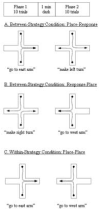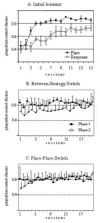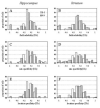Memory influences on hippocampal and striatal neural codes: effects of a shift between task rules
- PMID: 17240173
- PMCID: PMC1940837
- DOI: 10.1016/j.nlm.2006.09.008
Memory influences on hippocampal and striatal neural codes: effects of a shift between task rules
Abstract
Interactions with neocortical memory systems may facilitate flexible information processing by hippocampus. We sought direct evidence for such memory influences by recording hippocampal neural responses to a change in cognitive strategy. Well-trained rats switched (within a single recording session) between the use of place and response strategies to solve a plus maze task. Maze and extramaze environments were constant throughout testing. Place fields demonstrated (in-field) firing rate and location-based reorganization [Leutgeb, S., Leutgeb, J. K., Barnes, C. A., Moser, E. I., McNaughton, B. L., & Moser, M. B. (2005). Independent codes for spatial and episodic memory in hippocampal neuronal ensembles. Science, 309, 619-623] after a task switch, suggesting that hippocampus encoded each phase of testing as a different context, or episode. The task switch also resulted in qualitative and quantitative changes to discharge that were correlated with an animal's velocity or acceleration of movement. Thus, the effects of a strategy switch extended beyond the spatial domain, and the movement correlates were not passive reflections of the current behavioral state. To determine whether hippocampal neural responses were unique, striatal place and movement-correlated neurons were simultaneously recorded with hippocampal neurons. Striatal place and movement cells exhibited a response profile that was similar, but not identical, to that observed for hippocampus after a strategy switch. Thus, retrieval of a different memory led both neural systems to represent a different context. However, hippocampus may play a special (though not exclusive) role in flexible spatial processing since correlated firing amongst cell pairs was highest when rats successfully switched between two spatial tasks. Correlated firing by striatal cell pairs increased following any strategy switch, supporting the view that striatum codes change in reinforcement contingencies.
Figures








Similar articles
-
Striatal versus hippocampal representations during win-stay maze performance.J Neurophysiol. 2009 Mar;101(3):1575-87. doi: 10.1152/jn.91106.2008. Epub 2009 Jan 14. J Neurophysiol. 2009. PMID: 19144741 Free PMC article.
-
Parallel processing across neural systems: implications for a multiple memory system hypothesis.Neurobiol Learn Mem. 2004 Nov;82(3):278-98. doi: 10.1016/j.nlm.2004.07.007. Neurobiol Learn Mem. 2004. PMID: 15464410 Review.
-
Context-dependent reorganization of spatial and movement representations by simultaneously recorded hippocampal and striatal neurons during performance of allocentric and egocentric tasks.Behav Neurosci. 2004 Aug;118(4):751-69. doi: 10.1037/0735-7044.118.4.751. Behav Neurosci. 2004. PMID: 15301602
-
Task-dependent encoding of space and events by striatal neurons is dependent on neural subtype.Neuroscience. 2008 May 2;153(2):349-60. doi: 10.1016/j.neuroscience.2008.01.081. Epub 2008 Mar 4. Neuroscience. 2008. PMID: 18406064 Free PMC article.
-
Hippocampal place fields: a neural code for episodic memory?Hippocampus. 2006;16(9):685-90. doi: 10.1002/hipo.20209. Hippocampus. 2006. PMID: 16881080 Review. No abstract available.
Cited by
-
The form and function of hippocampal context representations.Neurosci Biobehav Rev. 2014 Mar;40:52-61. doi: 10.1016/j.neubiorev.2014.01.005. Epub 2014 Jan 22. Neurosci Biobehav Rev. 2014. PMID: 24462752 Free PMC article. Review.
-
Double dissociation and hierarchical organization of strategy switches and reversals in the rat PFC.Behav Neurosci. 2009 Oct;123(5):1028-35. doi: 10.1037/a0016822. Behav Neurosci. 2009. PMID: 19824768 Free PMC article.
-
Context-dependent extinction learning emerging from raw sensory inputs: a reinforcement learning approach.Sci Rep. 2021 Feb 1;11(1):2713. doi: 10.1038/s41598-021-81157-z. Sci Rep. 2021. PMID: 33526840 Free PMC article.
-
Striatal versus hippocampal representations during win-stay maze performance.J Neurophysiol. 2009 Mar;101(3):1575-87. doi: 10.1152/jn.91106.2008. Epub 2009 Jan 14. J Neurophysiol. 2009. PMID: 19144741 Free PMC article.
-
Hippocampal context processing is critical for interference free recall of odor memories in rats.Hippocampus. 2012 Apr;22(4):906-13. doi: 10.1002/hipo.20953. Epub 2011 May 3. Hippocampus. 2012. PMID: 21542056 Free PMC article.
References
-
- Anagnostaras SG, Gale GD, Fanselow MS. Hippocampus and contextual fear conditioning: recent controversies and advances. Hippocampus. 2001;11:8–17. - PubMed
-
- Buzsaki G. Theta rhythm of navigation: link between path integration and landmark navigation, episodic and semantic memory. Hippocampus. 2005;15:827–840. - PubMed
-
- Fanselow MS, Poulos AM. The neuroscience of mammalian associative learning. Annual Reviews of Psychology. 2005;56:207–234. - PubMed
-
- Ferbinteanu J, Shapiro ML. Prospective and retrospective memory coding in the hippocampus. Neuron. 2003;40:1227–1239. - PubMed
Publication types
MeSH terms
Grants and funding
LinkOut - more resources
Full Text Sources
Medical

